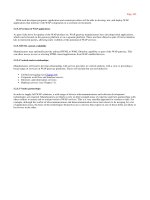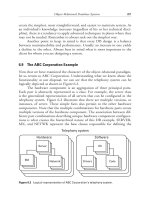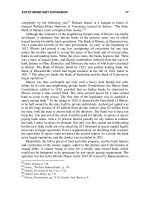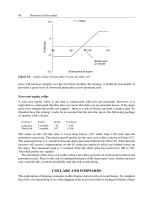Java Concepts 5th Edition and 6th phần 5 pptx
Bạn đang xem bản rút gọn của tài liệu. Xem và tải ngay bản đầy đủ của tài liệu tại đây (1.3 MB, 111 trang )
Java Concepts, 5th Edition
RANDOM FACT 7.2: The Therac-25 Incidents
The Therac-25 is a computerized device to deliver radiation treatment to cancer
patients (see Typical Therac-25 Facility). Between June 1985 and January 1987,
several of these machines delivered serious overdoses to at least six patients,
killing some of them and seriously maiming the others.
The machines were controlled by a computer program. Bugs in the program were
directly responsible for the overdoses. According to Leveson and Turner [4], the
program was written by a single programmer, who had since left the
manufacturing company producing the device and could not be located. None of
the company employees interviewed could say anything about the educational
level or qualifications of the programmer.
The investigation by the federal Food and Drug Administration (FDA) found that
the program was poorly documented and that there was neither a specification
document nor a formal test plan. (This should make you think. Do you have a
formal test plan for your programs?)
The overdoses were caused by an amateurish design of the software that had to
control different devices concurrently, namely the keyboard, the display, the
printer, and of course the radiation device itself. Synchronization and data sharing
between the tasks were done in an ad hoc way, even though safe multitasking
techniques were known at the time. Had the programmer enjoyed a formal
education that involved these techniques, or taken the effort to study the literature,
a safer machine could have been built. Such a machine would have probably
involved a commercial multitasking system, which might have required a more
expensive computer.
The same flaws were present in the software controlling the predecessor model,
the Therac-20, but that machine had hardware interlocks that mechanically
prevented overdoses.
321
322
Chapter 7 Arrays and Array Lists Page 48 of 67
Java Concepts, 5th Edition
Typical Therac-25 Facility
The hardware safety devices were removed in the Therac-25 and replaced by
checks in the software, presumably to save cost.
Frank Houston of the FDA wrote in 1985: “A significant amount of software for
life-critical systems comes from small firms, especially in the medical device
industry; firms that fit the profile of those resistant to or uninformed of the
principles of either system safety or software engineering” [4].
Who is to blame? The programmer? The manager who not only failed to ensure
that the programmer was up to the task but also didn't insist on comprehensive
testing? The hospitals that installed the device, or the FDA, for not reviewing the
design process? Unfortunately, even today there are no firm standards of what
constitutes a safe software design process.
CHAPTER SUMMARY
1. An array is a sequence of values of the same type.
322
323
Chapter 7 Arrays and Array Lists Page 49 of 67
Java Concepts, 5th Edition
2. You access array elements with an integer index, using the notation a[i].
3. Index values of an array range from 0 to length - 1. Accessing a
nonexistent element results in a bounds error.
4. Use the length field to find the number of elements in an array.
5. The ArrayList class manages a sequence of objects.
6. The ArrayList class is a generic class: ArrayList<T> collects objects of
type T.
7. To treat primitive type values as objects, you must use wrapper classes.
8. The enhanced for loop traverses all elements of a collection.
9. To count values in an array list, check all elements and count the matches until
you reach the end of the array list.
10. To find a value in an array list, check all elements until you have found a match.
11. To compute the maximum or minimum value of an array list, initialize a
candidate with the starting element. Then compare the candidate with the
remaining elements and update it if you find a larger or smaller value.
12. Two-dimensional arrays form a tabular, two-dimensional arrangement. You
access elements with an index pair a[i][j].
13. An array variable stores a reference to the array. Copying the variable yields a
second reference to the same array.
14. Use the clone method to copy the elements of an array.
15. Use the System.arraycopy method to copy elements from one array to
another.
16. Avoid parallel arrays by changing them into arrays of objects.
17. A test suite is a set of tests for repeated testing.
323
324
Chapter 7 Arrays and Array Lists Page 50 of 67
Java Concepts, 5th Edition
18. Regression testing involves repeating previously run tests to ensure that known
failures of prior versions do not appear in new versions of the software.
FURTHER READING
1. Barton P. Miller, Louis Fericksen, and Bryan So, “An Empirical Study of
the Reliability of Unix Utilities”, Communications of the ACM, vol. 33,
no. 12 (December 1990), pp. 32–44.
2. Peter J. Denning, Computers under Attack, Addison-Wesley, 1990.
3. Cliff Stoll, The Cuckoo's Egg, Doubleday, 1989.
4. Nancy G. Leveson and Clark S. Turner, “An Investigation of the
Therac-25 Accidents,” IEEE Computer, July 1993, pp. 18–41.
CLASSES, OBJECTS, AND METHODS INTRODUCED IN THIS
CHAPTER
java.lang.Boolean
booleanValue
java.lang.Double
doubleValue
java.lang.Integer
intValue
java.lang.System
arraycopy
java.util.ArrayList<E>
add
get
remove
set
size
REVIEW EXERCISES
★ Exercise R7.1. What is an index? What are the bounds of an array or array
list? What is a bounds error?
Chapter 7 Arrays and Array Lists Page 51 of 67
Java Concepts, 5th Edition
★ Exercise R7.2. Write a program that contains a bounds error. Run the
program. What happens on your computer? How does the error message
help you locate the error?
★★ Exercise R7.3. Write Java code for a loop that simultaneously computes
the maximum and minimum values of an array list. Use an array list of
accounts as an example.
★ Exercise R7.4. Write a loop that reads 10 strings and inserts them into an
array list. Write a second loop that prints out the strings in the opposite
order from which they were entered.
★★ Exercise R7.5. Consider the algorithm that we used for determining the
maximum value in an array list. We set largestYet to the starting
element, which meant that we were no longer able to use the “for each”
loop. An alternate approach is to initialize largestYet with null, then
loop through all elements. Of course, inside the loop you need to test
whether largestYet is still null. Modify the loop that finds the bank
account with the largest balance, using this technique. Is this approach
more or less efficient than the one used in the text?
★★★ Exercise R7.6. Consider another variation of the algorithm for
determining the maximum value. Here, we compute the maximum value
of an array of numbers.
double max = 0;// Contains an error!
for (x : values)
{
if (x > max) max = x;
}
However, this approach contains a subtle error. What is the error, and
how can you fix it?
★ Exercise R7.7. For each of the following sets of values, write code that
fills an array a with the values.
a. 1 2 3 4 5 6 7 8 9 10
b. 0 2 4 6 8 10 12 14 16 18 20
324
325
Chapter 7 Arrays and Array Lists Page 52 of 67
Java Concepts, 5th Edition
c. 1 4 9 16 25 36 49 64 81 100
d. 0 0 0 0 0 0 0 0 0 0
e. 1 4 9 16 9 7 4 9 11
Use a loop when appropriate.
★★ Exercise R7.8. Write a loop that fills an array a with 10 random numbers
between 1 and 100. Write code (using one or more loops) to fill a with 10
different random numbers between 1 and 100.
★ Exercise R7.9. What is wrong with the following loop?
double[] data = new double[10];
for (int i = 1; i <= 10; i++) data[i] = i * i;
Explain two ways of fixing the error.
★★★ Exercise R7.10. Write a program that constructs an array of 20 integers
and fills the first ten elements with the numbers 1, 4, 9, …, 100. Compile
it and launch the debugger. After the array has been filled with three
numbers, inspect it. What are the contents of the elements in the array
beyond those that you filled?
★★ Exercise R7.11. Rewrite the following loops without using the “for each”
construct. Here, data is an array of double values.
a. for (x : data) sum = sum + x;
b. for (x : data) if (x == target) return true;
c. int i = 0;
for (x : data) { data [i] = 2 * x; i++; }
★★ Exercise R7.12. Rewrite the following loops, using the “for each”
construct. Here, data is an array of double values.
a. for (int i = 0; i < data.length; i++) sum =
sum + data[i];
325
326
Chapter 7 Arrays and Array Lists Page 53 of 67
Java Concepts, 5th Edition
b. for (int i = 1; i < data.length; i++) sum =
sum + data[i];
c. for (int i = 0; i < data.length; i++)
if (data[i] == target) return i;
★★★ Exercise R7.13. Give an example of
a. A useful method that has an array of integers as a parameter that is
not modified.
b. A useful method that has an array of integers as a parameter that is
modified.
c. A useful method that has an array of integers as a return value.
Describe each method; don't implement the methods.
★★★ Exercise R7.14. A method that has an array list as a parameter can
change the contents in two ways. It can change the contents of individual
array elements, or it can rearrange the elements. Describe two useful
methods with ArrayList<BankAccount> parameters that change
an array list of BankAccount objects in each of the two ways just
described.
★ Exercise R7.15. What are parallel arrays? Why are parallel arrays
indications of poor programming? How can they be avoided?
★★ Exercise R7.16. How do you perform the following tasks with arrays in
Java?
a. Test that two arrays contain the same elements in the same order
b. Copy one array to another
c. Fill an array with zeroes, overwriting all elements in it
d. Remove all elements from an array list
★ Exercise R7.17. True or false?
Chapter 7 Arrays and Array Lists Page 54 of 67
Java Concepts, 5th Edition
a. All elements of an array are of the same type.
b. Array subscripts must be integers.
c. Arrays cannot contain string references as elements.
d. Arrays cannot use strings as subscripts.
e. Parallel arrays must have equal length.
f. Two-dimensional arrays always have the same numbers of rows and
columns.
g. Two parallel arrays can be replaced by a two-dimensional array.
h. Elements of different columns in a two-dimensional array can have
different types.
★★ Exercise R7.18. True or false?
a. A method cannot return a two-dimensional array.
b. A method can change the length of an array parameter.
c. A method can change the length of an array list that is passed as a
parameter.
d. An array list can hold values of any type.
★T Exercise R7.19. Define the terms regression testing and test suite.
★T Exercise R7.20. What is the debugging phenomenon known as cycling?
What can you do to avoid it?
Additional review exercises are available in WileyPLUS.
PROGRAMMING EXERCISES
★ Exercise P7.1. Add the following methods to the Bank class:
326
327
Chapter 7 Arrays and Array Lists Page 55 of 67
Java Concepts, 5th Edition
public void addAccount(int accountNumber,
double initialBalance)
public void deposit(int accountNumber, double
amount)
public void withdraw(int accountNumber,
double amount)
public double getBalance(int accountNumber)
★ Exercise P7.2. Implement a class Purse. A purse contains a collection of
coins. For simplicity, we will only store the coin names in an
ArrayList<String>. (We will discuss a better representation in
Chapter 8.) Supply a method
void addCoin(String coinName)
Add a method toString to the Purse class that prints the coins in the
purse in the format
Purse[Quarter,Dime,Nickel,Dime]
★ Exercise P7.3. Write a method reverse that reverses the sequence of coins
in a purse. Use the toString method of the preceding assignment to test
your code. For example, if reverse is called with a purse
Purse[Quarter,Dime,Nickel,Dime]
then the purse is changed to
Purse[Dime,Nickel,Dime,Quarter]
★ Exercise P7.4. Add a method to the Purse class
public void transfer(Purse other)
that transfers the contents of one purse to another. For example, if a is
Purse[Quarter,Dime,Nickel,Dime]
and b is
327
328
Chapter 7 Arrays and Array Lists Page 56 of 67
Java Concepts, 5th Edition
Purse[Dime,Nickel]
then after the call a.transfer(b), a is
Purse[Quarter,Dime,Nickel,Dime,Dime,Nickel]
and b is empty.
★ Exercise P7.5. Write a method for the Purse class
public boolean sameContents(Purse other)
that checks whether the other purse has the same coins in the same order.
★★ Exercise P7.6. Write a method for the Purse class
public boolean sameCoins(Purse other)
that checks whether the other purse has the same coins, perhaps in a
different order. For example, the purses
Purse[Quarter,Dime,Nickel,Dime]
and
Purse[Nickel,Dime,Dime,Quarter]
should be considered equal.
You will probably need one or more helper methods.
★★ Exercise P7.7. A Polygon is a closed curve made up from line segments
that join the polygon's corner points. Implement a class Polygon with
methods
public double perimeter()
and
Chapter 7 Arrays and Array Lists Page 57 of 67
Java Concepts, 5th Edition
public double area()
that compute the circumference and area of a polygon. To compute the
perimeter, compute the distance between adjacent points, and total up the
distances. The area of a polygon with corners (x
0
, y
0
),…, (x
n−1
, y
n−1
) is
( + + ⋯ + − − − ⋯ − )
1
2
x
0
y
0
x
1
y
2
x
n − 1
y
0
y
0
x
1
y
1
x
2
y
n − 1
x
0
As test cases, compute the perimeter and area of a rectangle and of a
regular hexagon. Note: You need not draw the polygon—that is done in
Exercise P7.15.
★ Exercise P7.8. Write a program that reads a sequence of integers into an
array and that computes the alternating sum of all elements in the array. For
example, if the program is executed with the input data
1 4 9 16 9 7 4 9 11
then it computes
1 − 4 + 9 − 16 + 9 − 7 + 4 − 9 + 11 = − 2
PROGRAMMING EXERCISES
★★ Exercise P7.9. Write a program that produces random permutations of the
numbers 1 to 10. To generate a random permutation, you need to fill an
array with the numbers 1 to 10 so that no two entries of the array have the
same contents. You could do it by brute force, by calling
Random.nextInt until it produces a value that is not yet in the array.
Instead, you should implement a smart method. Make a second array and
fill it with the numbers 1 to 10. Then pick one of those at random, remove
it, and append it to the permutation array. Repeat 10 times. Implement a
class Permutation Generator with a method
int[] nextPermutation
328
329
Chapter 7 Arrays and Array Lists Page 58 of 67
Java Concepts, 5th Edition
★★ Exercise P7.10. Add a method getWinner to the TicTacToe class of
Section 7.6. It should return "x" or "o" to indicate a winner, or " " if
there is no winner yet. Recall that a winning position has three matching
marks in a row, column, or diagonal.
★★★ Exercise P7.11. Write an application that plays tic-tac-toe. Your
program should draw the game board, change players after every
successful move, and pronounce the winner.
★★ Exercise P7.12. Magic squares. An n×n matrix that is filled with the
numbers 1, 2, 3, …, n
2
is a magic square if the sum of the elements in each
row, in each column, and in the two diagonals is the same value. For
example,
16 3 2 13
5 10 11 8
9 6 7 12
4 15 14 1
Write a program that reads in n
2
values from the keyboard and tests
whether they form a magic square when arranged as a square matrix. You
need to test three features:
• Did the user enter n
2
numbers for some n?
• Do each of the numbers 1, 2, …, n
2
occur exactly once in the user
input?
• When the numbers are put into a square, are the sums of the rows,
columns, and diagonals equal to each other?
If the size of the input is a square, test whether all numbers between 1 and
n
2
are present. Then compute the row, column, and diagonal sums.
Implement a class Square with methods
public void add(int i)
public boolean isMagic()
Chapter 7 Arrays and Array Lists Page 59 of 67
Java Concepts, 5th Edition
★★ Exercise P7.13. Implement the following algorithm to construct magic
n-by-n
2
squares; it works only if n is odd. Place a 1 in the middle of the
bottom row. After k has been placed in the (i, j) square, place k+1 into the
square to the right and down, wrapping around the borders. However, if the
square to the right and down has already been filled, or if you are in the
lower-right corner, then you must move to the square straight up instead.
Here is the 5×5 square that you get if you follow this method:
11 18 25 2 9
10 12 19 21 3
4 6 13 20 22
23 5 7 14 16
17 24 1 8 15
Write a program whose input is the number n and whose output is the
magic square of order n if n is odd. Implement a class MagicSquare
with a constructor that constructs the square and a toString method that
returns a representation of the square.
★G Exercise P7.14. Implement a class Cloud that contains an array list of
Point 2D.Double objects. Support methods
public void add(Point2D.Double aPoint)
public void draw(Graphics2D g2)
Draw each point as a tiny circle.
Write a graphical application that draws a cloud of 100 random points.
★★G Exercise P7.15. Implement a class Polygon that contains an array list
of Point2D.Double objects. Support methods
public void add(Point2D.Double aPoint)
public void draw(Graphics2D g2)
Draw the polygon by joining adjacent points with a line, and then closing
it up by joining the end and start points.
329
330
Chapter 7 Arrays and Array Lists Page 60 of 67
Java Concepts, 5th Edition
Write a graphical application that draws a square and a pentagon using
two Polygon objects.
★G Exercise P7.16. Write a class Chart with methods
public void add(int value)
public void draw(Graphics2D g2)
that displays a stick chart of the added values, like this:
You may assume that the values are pixel positions.
★★G Exercise P7.17. Write a class BarChart with methods
public void add(double value)
public void draw(Graphics2D g2)
that displays a chart of the added values. You may assume that all values
in data are positive. Stretch the bars so that they fill the entire area of the
screen. You must figure out the maximum of the values, and then scale
each bar.
★★★G Exercise P7.18. Improve the BarChart class of Exercise P7.17 to
work correctly when the data contains negative values.
★★G Exercise P7.19. Write a class PieChart with methods
public void add (double value)
public void draw(Graphics2D g2)
that displays a pie chart of the values in data. You may assume that all
data values are positive.
330
331
Chapter 7 Arrays and Array Lists Page 61 of 67
Java Concepts, 5th Edition
Additional programming exercises are available in WileyPLUS.
PROGRAMMING PROJECTS
★★★ Project 7.1. Poker Simulator. In this assignment, you will implement a
simulation of a popular casino game usually called video poker. The card
deck contains 52 cards, 13 of each suit. At the beginning of the game, the
deck is shuffled. You need to devise a fair method for shuffling. (It does
not have to be efficient.) Then the top five cards of the deck are
presented to the player. The player can reject none, some, or all of the
cards. The rejected cards are replaced from the top of the deck. Now the
hand is scored. Your program should pronounce it to be one of the
following:
• No pair—The lowest hand, containing five separate cards that do
not match up to create any of the hands below.
• One pair—Two cards of the same value, for example two queens.
• Two pairs—Two pairs, for example two queens and two 5’s.
• Three of a kind—Three cards of the same value, for example three
queens.
• Straight—Five cards with consecutive values, not necessarily of
the same suit, such as 4, 5, 6, 7, and 8. The ace can either precede
a 2 or follow a king.
• Flush—Five cards, not necessarily in order, of the same suit.
• Full House—Three of a kind and a pair, for example three queens
and two 5's
• Four of a Kind—Four cards of the same value, such as four queens.
• Straight Flush—A straight and a flush: Five cards with
consecutive values of the same suit.
Chapter 7 Arrays and Array Lists Page 62 of 67
Java Concepts, 5th Edition
• Royal Flush—The best possible hand in poker. A 10, jack, queen,
king, and ace, all of the same suit.
If you are so inclined, you can implement a wager. The player pays a
JavaDollar for each game, and wins according to the following payout
chart:
Hand Payout Hand Payout
Royal Flush 250 Straight 4
Straight Flush 50 Three of a Kind 3
Four of a Kind 25 Two Pair 2
Full House 6 Pair of Jacks or Better 1
Flush 5
★★★ Project 7.2. The Game of Life is a well-known mathematical game that
gives rise to amazingly complex behavior, although it can be specified
by a few simple rules. (It is not actually a game in the traditional sense,
with players competing for a win.) Here are the rules. The game is
played on a rectangular board. Each square can be either empty or
occupied. At the beginning, you can specify empty and occupied cells in
some way; then the game runs automatically. In each generation, the
next generation is computed. A new cell is born on an empty square if it
is surrounded by exactly three occupied neighbor cells. A cell dies of
overcrowding if it is surrounded by four or more neighbors, and it dies of
loneliness if it is surrounded by zero or one neighbor. A neighbor is an
occupant of an adjacent square to the left, right, top, or bottom or in a
diagonal direction. Figure 13 shows a cell and its neighbor cells.
Many configurations show interesting behavior when subjected to these
rules. Figure 14 shows a glider, observed over five generations. Note
how it moves. After four generations, it is transformed into the identical
shape, but located one square to the right and below.
One of the more amazing configurations is the glider gun: a complex
collection of cells that, after 30 moves, turns back into itself and a glider
(see Figure 15).
331
332
Chapter 7 Arrays and Array Lists Page 63 of 67
Java Concepts, 5th Edition
Figure 13
Neighborhood of a Cell in the Game of Life
Figure 14
Glider
332
Chapter 7 Arrays and Array Lists Page 64 of 67
Java Concepts, 5th Edition
Figure 15
Glider Gun
Program the game to eliminate the drudgery of computing successive
generations by hand. Use a two-dimensional array to store the
rectangular configuration. Write a program that shows successive
332
333
333
334
Chapter 7 Arrays and Array Lists Page 65 of 67
Java Concepts, 5th Edition
generations of the game. You may get extra credit if you implement a
graphical application that allows the user to add or remove cells by
clicking with the mouse.
ANSWERS TO SELF-CHECK QUESTIONS
1. 0, 1, 4, 9, 16, 25, 36, 49, 64, 81, but not 100.
2.
a. 0
b. a run-time error: array index out of bounds
c. a compile-time error: c is not initialized
3. new String[10];
new ArrayList<String>();
4. names contains the strings "B" and "C" at positions 0 and 1.
5. double is one of the eight primitive types. Double is a class type.
6. data.set(0, data.get(0) + 1);
7. for (double x : data) System.out.println(x);
8. The loop writes a value into data[i]. The “for each” loop does not have
the index variable i.
9. It returns the first match that it finds.
10. Yes, but the first comparison would always fail.
11. int[][] array = new int[4][4];
12. int count = 0;
for (int i = 0; i < ROWS; i++)
for (int j = 0; j < COLUMNS; j++)
if (board[i][j].equals(" ")) count++;
Chapter 7 Arrays and Array Lists Page 66 of 67
Java Concepts, 5th Edition
13. Use the add and remove methods.
14. Allocating a new array and copying the elements is time-consuming. You
wouldn't want to go through the process every time you add an element.
15. It is possible to introduce errors when modifying code.
16. Add a test case to the test suite that verifies that the error is fixed.
17. There is no human user who would see the prompts because input is
provided from a file.
Chapter 7 Arrays and Array Lists Page 67 of 67
Java Concepts, 5th Edition
Chapter 8 Designing Classes
CHAPTER GOALS
• To learn how to choose appropriate classes to implement
• To understand the concepts of cohesion and coupling
• To minimize the use of side effects
• To document the responsibilities of methods and their callers with
preconditions and postconditions
• To understand the difference between instance methods and static methods
• To introduce the concept of static fields
• To understand the scope rules for local variables and instance fields
• To learn about packages
T To learn about unit testing frameworks
In this chapter you will learn more about designing classes. First, we will discuss
the process of discovering classes and defining methods. Next, we will discuss how
the concepts of pre- and postconditions enable you to specify, implement, and invoke
methods correctly. You will also learn about several more technical issues, such as
static methods and variables. Finally, you will see how to use packages to organize
your classes.
8.1 Choosing Classes
You have used a good number of classes in the preceding chapters and probably
designed a few classes yourself as part of your programming assignments. Designing
a class can be a challenge—it is not always easy to tell how to start or whether the
result is of good quality.
335
335
336
Chapter 8 Designing Classes Page 1 of 71
Java Concepts, 5th Edition
Students who have prior experience with programming in another programming
language are used to programming functions. A function carries out an action. In
object-oriented programming, the actions appear as methods. Each method, however,
belongs to a class. Classes are collections of objects, and objects are not actions—
they are entities. So you have to start the programming activity by identifying objects
and the classes to which they belong.
Remember the rule of thumb from Chapter 2: Class names should be nouns, and
method names should be verbs.
A class should represent a single concept from the problem domain, such as
business, science, or mathematics.
What makes a good class? Most importantly, a class should represent a single
concept. Some of the classes that you have seen represent concepts from mathematics:
• Point
• Rectangle
• Ellipse
Other classes are abstractions of real-life entities.
• BankAccount
• CashRegister
For these classes, the properties of a typical object are easy to understand. A
Rectangle object has a width and height. Given a BankAccount object, you can
deposit and withdraw money. Generally, concepts from the part of the universe that a
program concerns, such as science, business, or a game, make good classes. The
name for such a class should be a noun that describes the concept. Some of the
standard Java class names are a bit strange, such as Ellipse2D.Double, but you
can choose better names for your own classes.
Another useful category of classes can be described as actors. Objects of an actor
class do some kinds of work for you. Examples of actors are the Scanner class of
Chapter 4 and the Random class in Chapter 6. A Scanner object scans a stream for
336
337
Chapter 8 Designing Classes Page 2 of 71
Java Concepts, 5th Edition
numbers and strings. A Random object generates random numbers. It is a good idea
to choose class names for actors that end in “-er” or “-or”. (A better name for the
Random class might be RandomNumberGenerator.)
Very occasionally, a class has no objects, but it contains a collection of related static
methods and constants. The Math class is a typical example. Such a class is called a
utility class.
Finally, you have seen classes with only a main method. Their sole purpose is to
start a program. From a design perspective, these are somewhat degenerate examples
of classes.
What might not be a good class? If you can't tell from the class name what an object
of the class is supposed to do, then you are probably not on the right track. For
example, your homework assignment might ask you to write a program that prints
paychecks. Suppose you start by trying to design a class PaycheckProgram. What
would an object of this class do? An object of this class would have to do everything
that the homework needs to do. That doesn't simplify anything. A better class would
be Paycheck. Then your program can manipulate one or more Paycheck objects.
Another common mistake, particularly by students who are used to writing programs
that consist of functions, is to turn an action into a class. For example, if your
homework assignment is to compute a paycheck, you may consider writing a class
ComputePaycheck. But can you visualize a “ComputePaycheck” object? The fact
that “ComputePaycheck” isn't a noun tips you off that you are on the wrong track. On
the other hand, a Paycheck class makes intuitive sense. The word “paycheck” is a
noun. You can visualize a paycheck object. You can then think about useful methods
of the Paycheck class, such as computeTaxes, that help you solve the
assignment.
SELF CHECK
1. What is the rule of thumb for finding classes?
2. Your job is to write a program that plays chess. Might ChessBoard be
an appropriate class? How about MovePiece?
337
Chapter 8 Designing Classes Page 3 of 71
Java Concepts, 5th Edition
8.2 Cohesion and Coupling
In this section you will learn two useful criteria for analyzing the quality of the public
interface of a class.
A class should represent a single concept. The public methods and constants that the
public interface exposes should be cohesive. That is, all interface features should be
closely related to the single concept that the class represents.
The public interface of a class is cohesive if all of its features are related to the
concept that the class represents.
If you find that the public interface of a class refers to multiple concepts, then that is a
good sign that it may be time to use separate classes instead. Consider, for example,
the public interface of the CashRegister class in Chapter 4:
public class CashRegister
{
public void enterPayment(int dollars, int
quarters,
int dimes, int nickels, int pennies)
. . .
public static final double NICKEL_VALUE = 0.05;
public static final double DIME_VALUE = 0.1;
public static final double QUARTER_VALUE = 0.25;
. . .
}
There are really two concepts here: a cash register that holds coins and computes their
total, and the values of individual coins. (For simplicity, we assume that the cash
register only holds coins, not bills. Exercise P8.1 discusses a more general solution.)
It makes sense to have a separate Coin class and have coins responsible for knowing
their values.
public class Coin
{
public Coin(double aValue, String aName) { . . . }
public double getValue() { . . . }
. . .
337
338
Chapter 8 Designing Classes Page 4 of 71
Java Concepts, 5th Edition
}
Figure 1
Dependency Relationship Between the CashRegister and Coin Classes
Then the CashRegister class can be simplified:
public class CashRegister
{
public void enterPayment(int coinCount, Coin
coinType) { . . . }
. . .
}
Now the CashRegister class no longer needs to know anything about coin values.
The same class can equally well handle euros or zorkmids!
This is clearly a better solution, because it separates the responsibilities of the cash
register and the coins. The only reason we didn't follow this approach in Chapter 4
was to keep the CashRegister example simple.
Many classes need other classes in order to do their jobs. For example, the
restructured CashRegister class now depends on the Coin class to determine the
value of the payment.
A class depends on another class if it uses objects of that class.
338
339
Chapter 8 Designing Classes Page 5 of 71









